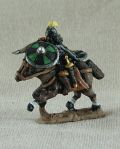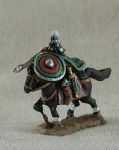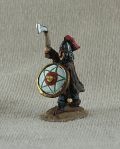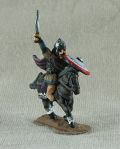Historical Overview Section
West Francia from 888-1050 AD
Despite having a hideously impressive name, this list is all about a rather short, unloved and frankly somewhat ginger kingdom that was part of the untended back garden of the western part of the Carolingian Frankish Empire. It accidentally came under the control of Charlemagne's grandson, Charles the Bald (Le tete du Skin in Olde French) as a result of the Treaty of Verdun (well, no-one else wanted it) in 843. This meant that the Carolingian Frankish Empire lasted only one generation after Charlemagne.
Charles the Bald (who might have been quite hairy apparently) sired a son, Robert the Strong (go figure), who founded the Robertian Dynasty. His son was Odo the Count of Paris (careful on the spelling there) and Marquis of Neustria. After his father's death in 886 Odo eventually inherited his father's titles (apart from the "The Strong" one). Odo was apparently a bit of a star at the Siege of Paris in leading Carolingian Frankish forces against the Normans (so, that's the Robertians vs the Normans. The Steve-ians, Dave-ians and Colin-inans were obviously busy at the time). This meant that Odo was chosen to be king by the Western Franks, as they had just removed the Emperor Charles the Fat (by leaving a cake outside his throne room, the slamming the door after he nipped out to get it). Odo continued to battle against the Normans, whom he defeated at Montfaucon, but was soon involved in a struggle with powerful nobles, who supported the claim of a man called Charles, and Odo lost out.
Charles the Third (no rhyming slang) was the undisputed King of France from 898 until 922. During his reign he was quite busy handing stuff away, and in 911 signed the Treaty of Saint-Clair-sur-Epte with the Viking King Rollo giving Rollo the lower Seine basin (but not the plates or spoons) in hope that Rollo would fend off future ((Viking) raids up the Seine. He also defended the country against two attacks by Conrad, King of the Early Medieval Germans.
Despite this, the locals kicked him out - but luckily, the Vikings in the Seine had by now morphed into Normans, and Charles was able to return in 923 with a Norman army - but was defeated on 15 June near Soissons by Robert (another Bob). Bob died in the battle, to be succeeded by Rudolph. No-one dared come up with the obvious nickname for Rudolph.
Rudolph's first act as king was to lead an army against King Henry I the Early Medieval German who tried to annex Lorraine (she was having none of it though). Henry the Early Medieval German monarch met Rudolph and a considerably-sized army and made peace - not really an option under the present edition of FoG. again. In 925 Henry managed to steal Lorraine from France permanently. At about this time the Vikings made a fresh series of raids into West Francia, attacking all over until Rudolph confronted them in Burgundy. The Vikings left, but the Normans, whom Charles had legally implanted around Rouen in 911, took up where the Vikings left off, and began ravaging the whole region. Charles then allied with the Early Medieval Germans, and had a dust-up with the Normans near Fauquembergues which got quite messy. In 930 the Magyars invaded Rheims, but left before the king could engage them. In 935, the Magyars invaded Burgundy and Rudolph brought a large army against them, causing their retreat without battle. Rudolph then beat the Vikings at Limousin, and had another stab at the Early Medieval Germans too before he corpsed it.
Louis IV was next, then the French-sounding Lothar who invaded Flanders, took on the Early Medieval Germans (again!), had various internal problems (from eating all that cheese presumably...) and did nothing in 985, when the Andalusian Caliph of Cordoba, Al-Mansur, sacked Astur-Leonese Barcelona. He was succeeded for a single year by Louis V (986-7) and then Hugh Capet took over.
Hugh had been on the side of the Early Medieval Germans for some time, but was elected the top man in France - although no-one outside Paris really cared that much. His big achievement was to sort out a proper succession plan, with his son the undisputed next monarch of France. Robert made few friends and many enemies, including his own sons: Hugh Magnus, Henry, and Robert. They turned against their father in a civil war over power and property. Hugh died in revolt in 1025. In a conflict with Henry and the younger Robert, King Robert's army was beaten and he retreated to Beaugency outside Paris, his capital. He died in the middle of the war with his sons on 20 July 1031 at Melun.
Henry ended up King, but basically ruled his own back garden - and that was only when his neighbours dogs weren't wanting to use it as a toilet. His smartest move was to help his very young nephew-in-law, the newly appointed Duke William of Normandy (who would go on to become William the Conqueror) to suppress a revolt by William's vassals. In 1047, Henry secured the dukedom for William in their decisive victory over the vassals at the Battle of Val-ès-Dunes near Caen. When he dies the army list becomes the Feudal French one.
Using the army in FoG
- Lets face it, it's a big cavalry charge and some lurking spearmen at the back.
- Crossbows can be OK against armoured cavalry - and there will be a lot in this period. LF are generally better, as they can move faster, skirmish, and don't lose too many dice vs MF in shooting, but you may want 1 unit of MF if you are to support your spearmen.
- 3 units of 4 is quite rare in this book - worth taking to boost army size. the cavalry aren't cheap.
UK Tournament Results with this army
Useful Links
User-contributed links about this army:
- Register and you can put you own link in here and then write some brief detail about the link here
- Register and you can put you own link in here and then write some brief detail about the link here
- put the link text readers will see in here write some more detail about the link here
Allies
- French, Early Medieval (Internal Ally) Any Wolves from the Sea 61 Lots of lancers and a unit of supporting optional Def Sp foot. More of the same, but allows you to sneak in some more 4-strong units for padding.
- Norman From 923 Wolves from the Sea 66 Lancers, optional def Sp, and a 4-strong of LF bow for bulk
- Viking Before 923 Wolves from the Sea 40 Large numbers of protected offensive spear, and a hard-core of optional ones with armour or heavy weapon
Painting and Collecting the Army
- Paint schemes, insignia, shield designs? Put it here.
15mm Manufacturers supplying figures for this army
Early in the period you want to use Carolingian type figures, like these. later on they become very close to Normans which you can get to from that link. You can see some of the figures in the Ancients Photo Gallery also on this site

|

|

|

|
- Essex Miniatures - sell Middle Frankish army sets
- Donnington Merovingians and Aquitanians amongst others around this era.
- Gladiator Miniatures by Fighting 15's (Gladiator Games) generic dark age ranges
- Old Glory Frankish/Later German range
- Magister Militum (includes former Chariot ranges) Navigators dark ages ranges include Saxons
- Museum Their Franks are OK for this period
- Minifigs UK figures for this era in their dark ages section
- Lancashire Games worth looking at their Goths, Saxons and Lombards
- LKM/QRF (Feudal Castings & Friekorps ranges) Vikings?
- Tin Soldier Saxons, Carolingians
- 2 Dragons Vikings Anglo-Saxons, Slavs, Carolingians & Normans may have approriate figures
- Khurasan - newish Frankish ranges
- Viking Forge Franks & Vikings
- Isarus their Saxons will do
- Camelot Games (Italy) Vikings maybe ?
- MY Miniatures Saxons and SRB may be OK
- Miniature Wars Dark Age Franks
- Splintered Light Romano British & Early Saxon ranges will work OK
- Baueda New Norman range to complement their existing Viking range
Army Lists
- 1 Archers LF Unprotected Average Undrilled bow - - 6
- 2 Archers LF Unprotected Average Undrilled bow - - 6
- 3 Crossbowmen LF Unprotected Average Undrilled Crossbow - - 4
- 4 Gascons LH Unprotected Average Undrilled javelins light spear - 4
- 5 Gascons LF Unprotected Average Undrilled javelins light spear - 6
- 6 Spearmen HF Protected Average Undrilled - defensive spearmen - 6
- 7 Spearmen HF Protected Average Undrilled - defensive spearmen - 6
- 8 Spearmen HF Protected Average Undrilled - defensive spearmen - 6
- 9 Spearmen HF Protected Average Undrilled - defensive spearmen - 6
- 10 Cavalry Cv Armoured superior Undrilled - lancers Swordsmen 4
- 11 Cavalry Cv Armoured superior Undrilled - lancers Swordsmen 4
- 12 Cavalry Cv Armoured superior Undrilled - lancers Swordsmen 4
- 13 Cavalry Cv Armoured superior Undrilled - lancers Swordsmen 4
- 14 Cavalry Cv Armoured superior Undrilled - lancers Swordsmen 4
- 15 Cavalry Cv Armoured superior Undrilled - lancers Swordsmen 4
- Sub-commanders TC - - - - - - 4
Fairly simple plan - 6 units of knights!
Remember to leave a line before you copy the above section as a template for your own list
eBay Listings
UK Bookstore